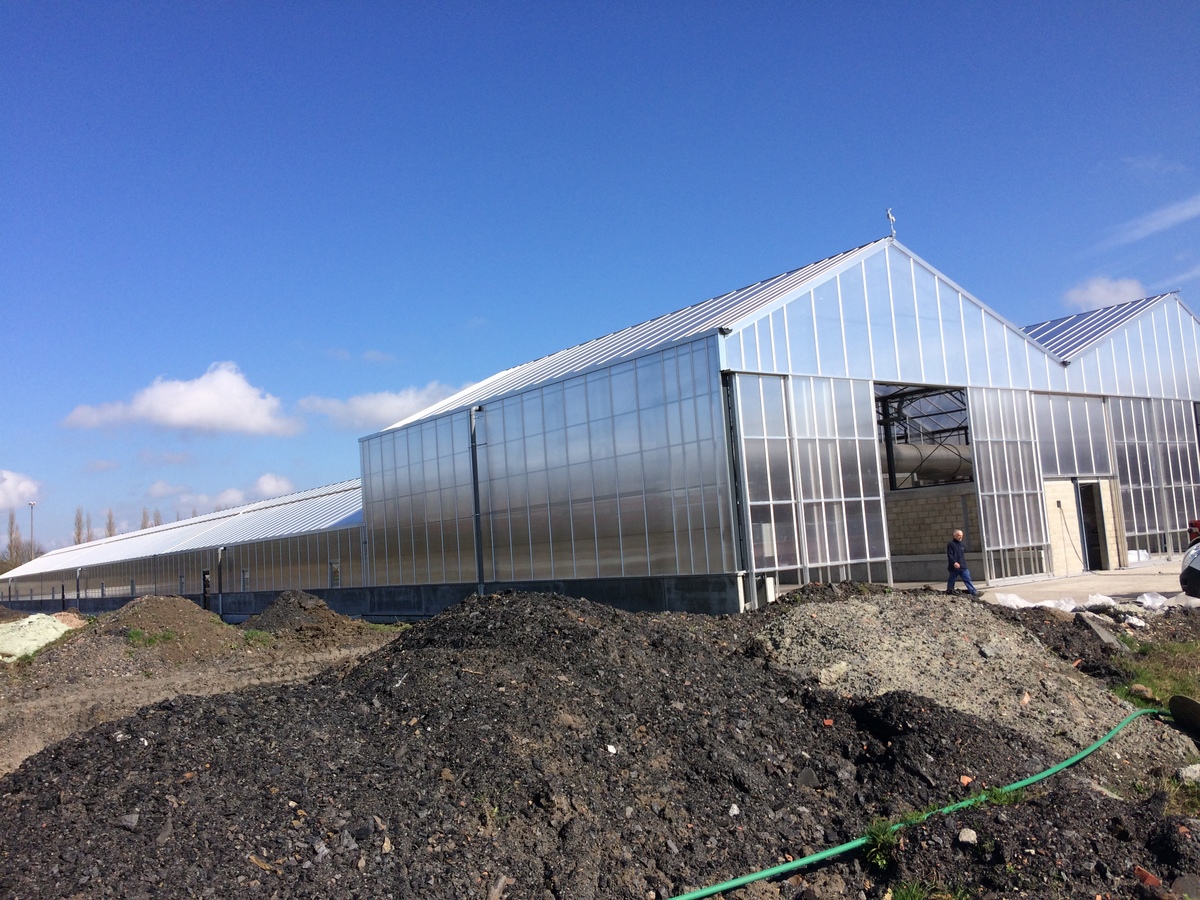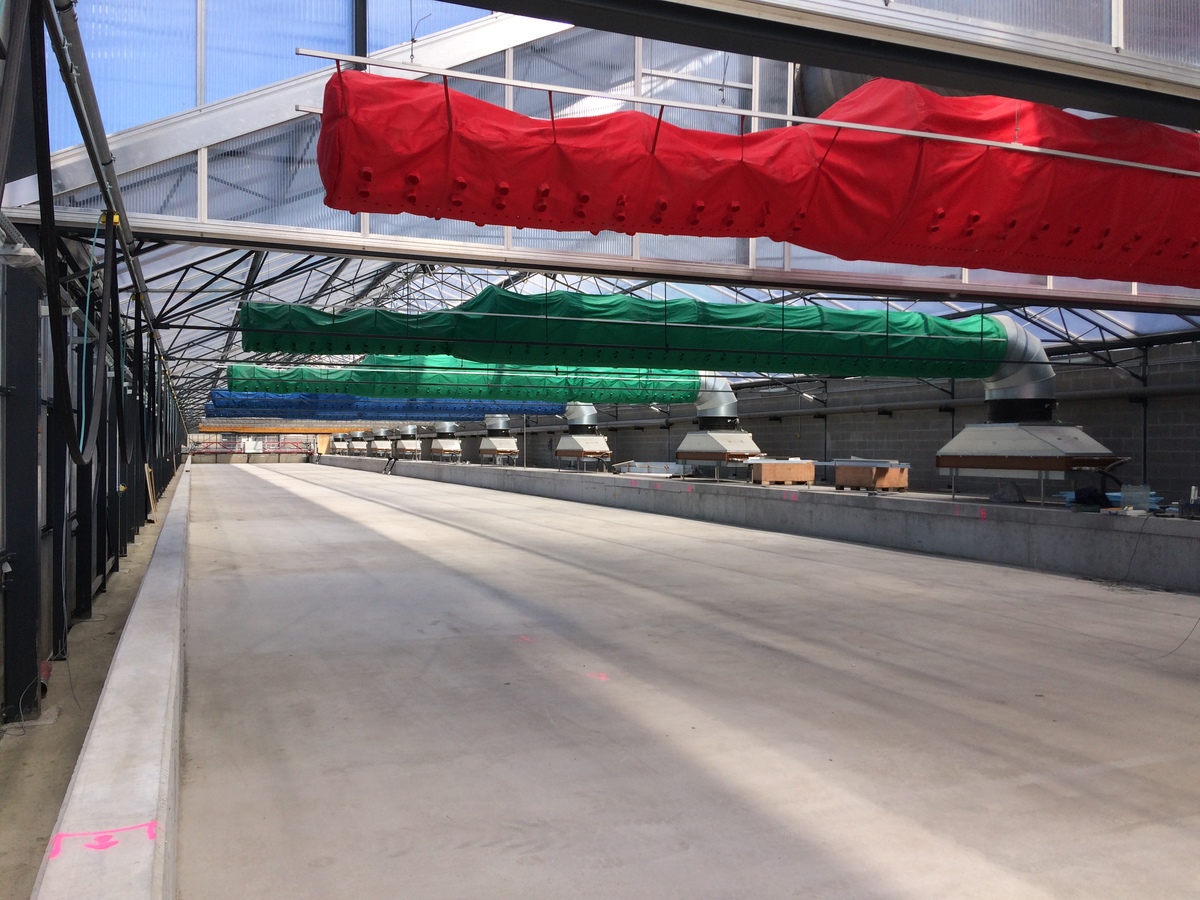Greenhouses for drying and recovery of sewage sludge
Last modified by the author on 16/06/2017 - 10:59
- Year of commitment : 2017
- Address 1 - street : CHASSE DES PRèS - 7390 WASMUëL, Belgique
- CO2 Impact : Gain of 2.100 tonnes of CO2/year
- Green energies : Thermal solar, Geothermal, Biogas, Recovering of fatal energy, Energy Efficiency
- Digital services : Water, Waste
- Water cycle : Drilling, Used water recycling
- Circular economy and waste management : Industrial Ecology, Save of ressources
-
6 000 000 €
- Builder
4 companies: Persyn, Deforges, Druart and Munters - Manager / Dealer
IDEA - SPGE
Tool for solar and geothermal drying of the wastewater treatment plant in Wasmuël and production of thermal and electrical energy
INTRODUCTION
The protection of natural resources and the management of costs constitute genuine environmental and financial challenges for the Walloon water sector. In particular, the management of sludge resulting from the purification activity represents, on the one hand, a significant annual financial burden of about 15% of the annual operating balance sheet and, on the other hand, a source Of consequent potential energy. Energy consumption, in all its forms, accounts for 20% of the annual financial balance sheet.
IDEA (Intercommunal of Economic Development and Development of the Heart of Hainaut), on behalf of the SPGE, manages about thirty wastewater treatment plants in the province of Hainaut, producing annually around 20,000 tons sludge. Wastewater treatment in Wallonia is financed by the SPGE (Public Water Management Company) on the basis of a True Sanitation Cost (CVA) levied on each m³ of water consumed.
On the basis of these findings and the distribution of the costs of thermal sludge drying in which the energy represents more than 50% of the total cost, the sludge drying by the use of a fatal, residual low-cost energy see At zero cost, can be an important parameter for reducing the cost of treatment, evacuation and CO2 emissions. The use of energy recovery downstream of drying can also constitute a probative path that is part of the approach of the circular economy and aims to innovate in the field of the valorisation of sewage sludge while contributing to the Of the wastewater treatment plant from the energy point of view.
1. GEOTHERMAL ENERGY IN THE HENNUYERE REGION
Since the 1980s, through the operation of two wells located in Saint-Ghislain and Baudour, IDEA has developed geothermal water resources (naturally warm groundwater).
With a geothermal gradient of 30 ° C / km, the geothermal water of Saint-Ghislain, drawn at more than 2500 m depth, has a temperature at the outlet of wells of 72 ° C. This energy is recovered for the heating of public buildings (hospitals, schools, social housing, etc.) and companies, with a temperature regime close to 70/50 ° C. The total energy delivered represents the equivalent of 20 MWh in geothermal energy via district heating, ie a CO2 saving estimated at more than 5500 tons per year.
2. SOLAR AND GEOTHERMAL GREENHOUSES
The adequacy between the residual geothermal water at a temperature of 50 ° C and the need for low-cost energy makes it possible to develop on the site of the Wasmuël station a process of drying in cascade of the transmitters Internal, air introduction batteries) in the greenhouse, at low energy cost with a temperature regime of 50/30 ° C.
In the context of drying sludge from the Wasmuël wastewater treatment plant, the use of zero-cost geothermal residual energy allows the project's economic profitability with increased performance linked to the use of this energy. The desired objectives are firstly drying with a final dryness of greater than 80%, resulting in an increase of the PCI from about 4 MJ / kg to about 14 MJ / kg allowing other recovery processes. This process will reduce the volume of sludge by a factor of 4 and thus the cost of storage and disposal, it will give a finished product in the form of dry, hard and odorless granulate, it will increase stabilization and hygienisation and , And it will facilitate their energy (combustion) and agricultural (spreading) recovery.
A technical-economic study of the various processes of drying sludge from the treatment plant allowed the suitability of the type of dryer and the objectives sought on the basis of all the parameters studied (energy source, implantation, tonnage , Solar / geothermal drying has proven to be the most appropriate, efficient and rustic solution in our context with respect to low enthalpy residual energy, Of the proximity of the source of geothermal discharge. Within the framework of this study, various matrices have been developed, taking into account the crossing of parameters such as: investment, consumption, maintenance, exploitation, etc. These matrices allow a comparative evaluation of the various technologies.
Energetically, the removal of one tonne of water by solar drying consumes about 75 kWh of electricity against 80 to 130 kWh when using conventional thermal drying processes. This, in addition to the heating energy which is evaluated at about 700kWh thermal compared with 850 to 1150 kWh for the process
Progress Status
Delivered
Data Reliability
Self-declared
Funding Type
Public
Sustainable Development
Governance
IDEA - SPGE
Regional Authority
4 companies: Persyn, Deforges, Druart and Munters
Power producer
IDEA - SPGE
Public
A technical-economic study of the various processes used to dry sludge from a sewage treatment plant made it possible to adapt the type of dryer and the objectives sought on the basis of all the parameters studied (energy source, location, tonnage , regime of T °, etc). Solar / geothermal drying has proven to be the most appropriate, efficient and rustic solution in our context with respect to low enthalpy residual energy, of the significant ground-based right-of-way and proximity to the source of geothermal discharge. Within the framework of this study, various matrices have been developed, taking into account the crossing of parameters such as: investment, consumption, maintenance, exploitation, etc. These matrices allow a comparative evaluation of the various technologies.
Energetically, the removal of one tonne of water by solar drying consumes about 75 kWh of electricity against 80 to 130 kWh when using conventional thermal drying processes. This, in addition to heating energy which is rated at about 700kWh thermal compared with 850-1150kWh for conventional processes. Solar energy represents, for an average meteorological year at Wasmuël, about 25% of the energy required for drying.
On the proposal of IDEA, the SPGE decided to build two modules of greenhouses at the Wasmuël wastewater treatment plant, with a useful surface area of more than 2000m², in order to dry the sludge produced by sewage treatment plants managed by the Intercommunale. These modules will be commissioned in June 2017.
Sustainable Solutions
- Circular economy
- Infrastructure
- Waste management
- Renewable energies

SOLAR AND GEOTHERMAL GREENHOUSES
The adequacy between the residual geothermal water at a temperature of 50 ° C and the need for low-cost energy makes it possible to develop on the site of the Wasmuël station a process of drying in cascade of the transmittfers (loor heating, internal batteries, air intake batteries) in the greenhouse, at low energy cost with a temperature regime of 50/30 ° C. In the context of drying sludge from the Wasmuël wastewater treatment plant, the use of zero-cost geothermal residual energy allows the project's economic profitability with increased performance linked to the use of this energy. The desired objectives are firstly drying with a final dryness of greater than 80%, resulting in an increase of the PCI from about 4 MJ / kg to about 14 MJ / kg allowing other recovery processes. This process will reduce the volume of sludge by a factor of 4 and thus the cost of storage and disposal, it will give a finished product in the form of dry, hard and odorless granulate, it will increase stabilization and sanitization and finally, it will facilitate their energy (combustion) and agricultural (spreading) recovery. A technical-economic study of the various processes used to dry sludge from a sewage treatment plant made it possible to adapt the type of dryer and the objectives sought on the basis of all the parameters studied (energy source, location, tonnage , regime of T °, etc). Solar / geothermal drying has proven to be the most appropriate, efficient and rustic solution in our context with respect to low enthalpy residual energy, Of the major ground-based right-of-way and proximity to the source of geothermal discharge. Within the framework of this study, various matrices have been developed, taking into account the crossing of parameters such as: investment, consumption, maintenance, exploitation, etc. These matrices allow a comparative evaluation of the various technologies. Energetically, the removal of one tonne of water by solar drying consumes about 75 kWh of electricity against 80 to 130 kWh when using conventional thermal drying processes. This, in addition to heating energy which is rated at about 700kWh thermal compared with 850-1150kWh for conventional processes. Solar energy represents, for an average meteorological year at Wasmuël, about 25% of the energy required for drying. On the proposal of IDEA, the SPGE decided to build two modules of greenhouses at the Wasmuël wastewater treatment plant, with a useful surface area of more than 2000m², in order to dry the sludge produced by the sewage treatment plants managed by the Intercommunale. These modules will be commissioned in June 2017.
Reasons for participating in the competition(s)
Les points forts pour la catégorie « Cycle de l’eau » :• Utilisation de deux vecteurs énergétiques renouvelables solaire et résiduelle géothermique, zéro émission de CO2
• Augmentation des performances de séchage à 4 tonnes d’eau évaporé /m² alors qu’une serre traditionnelle a une performance de 0.8 tonne d’eau évaporé/m²
• Augmentation du taux de siccité de 25% à 85%
• Production de pellets séchés sans odeur ni poussière, hygiénisés
• Production de boues séchées à fort pouvoir énergétique, 16 MJ/kg (PCI du bois = 20 MJ/kg)
• Réduction du volume de boues initiale par un facteur 4 après séchage, de ce fait réduction du coût d’élimination/valorisation de ces boues
• Réduction du volume de boues initiale par un facteur 10 pour l’ensemble du cycle (séchage + gazéification), de ce fait réduction du coût d’élimination/valorisation
• Production d’électricité et de chaleur
• Economie de transport et des émissions de CO2 inhérentes au secteur par un facteur 10
• Autonomie énergétique thermique de l’ensemble du process de séchage des boues de stations d’épuration
• Autonomie énergétique électrique de l’ensemble du process de la station d’épuration de Wasmuël (250.000 EH) en fin de cycle (séchage +gazéification)
• Impact de ces économies cumulées sur le CVA (Coût-vérité assainissement) et donc sur la facture de l’ensemble des ménages
• ROI < 15 ans
• La technologie permet une localisation centralisée favorisant des économies d’échelles
• Séchage de boues de stations d’épuration régionales
• Création d’un cercle vertueux énergétique avec le process d’épuration dans son ensemble et du séchage des boues de stations d’épuration
• Rencontre des objectifs de la COP 21 en matière de réduction de gaz à effet de serre ainsi que des objectifs 20-20-20 définis par l’Europe au sein desquels la Wallonie s’est inscrite
• S’inscrit dans le développement de la station d’épuration du futur, station « zéro énergie »
• Projet porté dans le cadre d’un partenariat unissant IDEA, Intercommunale regroupant 27 communes du Cœur du Hainaut, et la SPGE, chargée de la coordination et du financement du secteur de l’eau en Wallonie
Les points forts pour la catégorie « Economie circulaire et déchets » :
• Utilisation de deux vecteurs énergétiques renouvelables solaire et résiduelle géothermique, zéro émission de CO2 pour le séchage
• Création d’un cercle vertueux énergétique avec le process d’épuration dans son ensemble et du séchage des boues de station d’épuration
• Réduction du volume de boues initiale par un facteur 4 après séchage, de ce fait réduction du coût d’élimination/valorisation de ces boues
• Réduction du volume de boues initiale par un facteur 10 pour l’ensemble du cycle (séchage + gazéification), de ce fait réduction du coût d’élimination/valorisation
• Production de boues séchées à fort pouvoir énergétique, 16 MJ/kg (PCI du bois = 20 MJ/kg)
• Production d’électricité et de chaleur grâce à la gazéification des pellets séchés
• Rendement global énergétique de la gazéification double de celui de la biométhanisation
• Production en final de résidus inertes après gazéification
• Coût d’élimination/valorisation divisé par 5 sur base du coût du kWh électrique actuel après gazéification
• Economie de transport et des émissions de CO2 inhérentes au secteur par un facteur 10
• La technologie permet une localisation centralisée favorisant les économies d’échelles
• Autonomie énergétique électrique de l’ensemble du process de la station d’épuration de Wasmuël (250.000 EH) en fin de cycle (séchage +gazéification)
• Autonomie énergétique thermique de l’ensemble du process de séchage des boues de stations d’épuration
• Séchage de boues de stations d’épuration régionales
• ROI < 15 ans
• Projet porté dans le cadre d’un partenariat unissant IDEA, Intercommunale regroupant 27 communes du Cœur du Hainaut, et la SPGE, chargée de la coordination et du financement du secteur de l’eau en Wallonie
• S’inscrit dans le développement de la station d’épuration du futur, station « zéro énergie »
• Rencontre des objectifs de la COP 21 en matière de réduction de gaz à effet de serre ainsi que des objectifs 20-20-20 définis par l’Europe au sein desquels la Wallonie s’est inscrite
Building candidate in the category

Users' Choice













